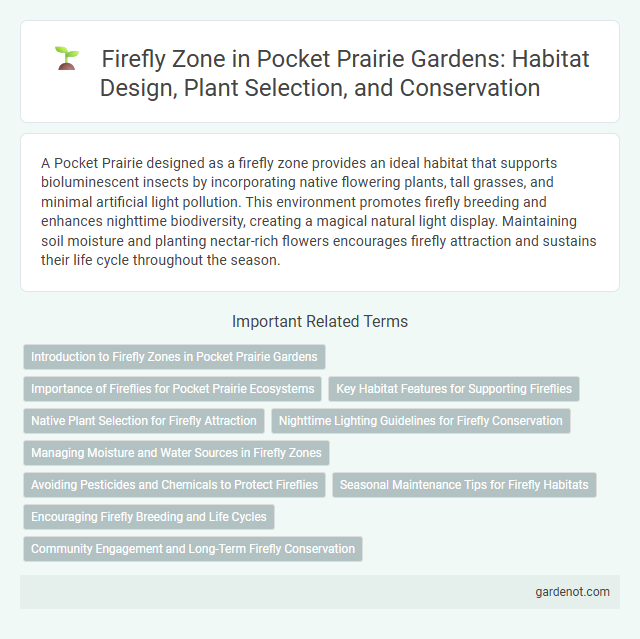A Pocket Prairie designed as a firefly zone provides an ideal habitat that supports bioluminescent insects by incorporating native flowering plants, tall grasses, and minimal artificial light pollution. This environment promotes firefly breeding and enhances nighttime biodiversity, creating a magical natural light display. Maintaining soil moisture and planting nectar-rich flowers encourages firefly attraction and sustains their life cycle throughout the season.
Introduction to Firefly Zones in Pocket Prairie Gardens
Firefly zones in Pocket Prairie Gardens create essential habitats that support the life cycle of fireflies by providing native grasses, wildflowers, and moist soil conditions. These designated areas promote biodiversity by attracting pollinators and nocturnal insects, enhancing ecosystem health and natural pest control. Firefly zones contribute to natural illumination during dusk, offering educational and aesthetic value to garden enthusiasts.
Importance of Fireflies for Pocket Prairie Ecosystems
Fireflies play a crucial role in Pocket Prairie ecosystems by aiding in natural pest control, as their larvae feed on harmful insects that can damage native plants. Their presence indicates a healthy environment, supporting biodiversity and enhancing the overall ecological balance within Pocket Prairies. Conserving firefly habitats ensures the sustainability of these miniature ecosystems, promoting pollination and nutrient cycling.
Key Habitat Features for Supporting Fireflies
Firefly zones in pocket prairies provide essential habitat features such as moist soil, abundant leaf litter, and native flowering plants that support bioluminescent mating displays and larval development. Dense vegetation offers shelter and hunting grounds for fireflies, while minimal light pollution enhances their bioluminescent communication. Preserving these conditions within pocket prairies is crucial for sustaining healthy firefly populations and promoting biodiversity.
Native Plant Selection for Firefly Attraction
Selecting native plants such as milkweed, goldenrod, and joe-pye weed creates an ideal firefly zone in a pocket prairie by providing essential nectar sources and habitat. These plants support the firefly's life cycle by attracting prey insects for larvae and offering protection during daylight hours. Incorporating diverse native species enhances firefly populations and promotes overall ecological balance within the prairie ecosystem.
Nighttime Lighting Guidelines for Firefly Conservation
Nighttime lighting in Pocket Prairie's Firefly Zone is minimized to protect firefly populations by reducing light pollution that disrupts their mating signals. Using low-intensity, amber-colored LED lights and motion sensors ensures habitat preservation while maintaining necessary visibility. Following these guidelines supports firefly conservation and promotes biodiversity within the prairie ecosystem.
Managing Moisture and Water Sources in Firefly Zones
Proper management of moisture and water sources in Pocket Prairie firefly zones promotes ideal habitat conditions by maintaining damp, sheltered areas essential for firefly larvae development. Incorporating shallow water features, such as moisture-retentive depressions and standing water, supports firefly breeding and increases their population density. Avoiding excessive watering and ensuring well-drained soil prevents habitat degradation and supports a balanced ecosystem for firefly sustainability.
Avoiding Pesticides and Chemicals to Protect Fireflies
Avoiding pesticides and chemicals in pocket prairie Firefly zones is essential to protect these bioluminescent insects, as toxic substances disrupt their breeding and feeding habitats. Maintaining organic, chemical-free soil supports larvae development and preserves the insects' natural ecosystem. Promoting pesticide-free practices enhances firefly populations, ensuring their crucial role in biodiversity and night-time pollination.
Seasonal Maintenance Tips for Firefly Habitats
Seasonal maintenance for Pocket Prairie firefly zones involves clearing overgrown vegetation and removing invasive plants to preserve suitable habitats for fireflies. Ensuring moist soil conditions during dry spells supports larval development, while minimizing artificial light pollution enhances firefly mating displays. Regularly monitoring the habitat for debris and maintaining native plant diversity promotes a thriving firefly population throughout the seasons.
Encouraging Firefly Breeding and Life Cycles
Creating a dedicated firefly zone within a pocket prairie enhances habitat suitability by providing native wildflowers and tall grasses essential for firefly breeding and larval development. Maintaining moist soil conditions and minimizing pesticide use supports the complete firefly life cycle, from eggs to larvae to adults. Incorporating standing water sources and avoiding artificial light pollution further encourages successful mating displays and population growth.
Community Engagement and Long-Term Firefly Conservation
The Firefly Zone within the Pocket Prairie serves as a vital hub for community engagement, fostering local participation through educational workshops and citizen science projects that monitor firefly populations. Collaborative efforts with schools and environmental organizations enhance awareness and stewardship, promoting sustainable practices that protect firefly habitats. Long-term firefly conservation is supported by habitat restoration, native plantings, and data-driven strategies that ensure resilient firefly populations and biodiversity in the Pocket Prairie ecosystem.
Firefly zone Infographic

 gardenot.com
gardenot.com